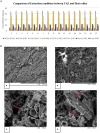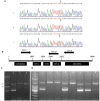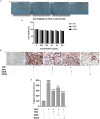Discrimination of Dendropanax morbifera via HPLC fingerprinting and SNP analysis and its impact on obesity by modulating adipogenesis- and thermogenesis-related genes
- PMID: 37621738
- PMCID: PMC10446900
- DOI: 10.3389/fnut.2023.1168095
Discrimination of Dendropanax morbifera via HPLC fingerprinting and SNP analysis and its impact on obesity by modulating adipogenesis- and thermogenesis-related genes
Abstract
Dendropanax morbifera (DM), a medicinal plant, is rich in polyphenols and commonly used to treat cancer, inflammation, and thrombosis. However, to date, no study has been conducted on DM regarding the enormous drift of secondary metabolites of plants in different regions of the Republic of Korea and their effects on antiobesity, to explore compounds that play an important role in two major obesity-related pathways. Here, we present an in-depth study on DM samples collected from three regions of the Republic of Korea [Jeju Island (DMJ), Bogildo (DMB), and Jangheung (DMJG)]. We used high-performance liquid chromatography (HPLC) and multivariate component analyses to analyze polyphenol contents (neochlorogenic acid, chlorogenic acid, cryptochlorogenic acid, and rutin), followed by discrimination of the samples in DMJG using single nucleotide polymorphism and chemometric analysis. In silico and in vitro evaluation of major compounds found in the plant extract on two major anti-obesity pathways (adipogenesis and thermogenesis) was carried out. Furthermore, two extraction methods (Soxhlet and ultrasound-assisted extraction) were used to understand which method is better and why. Upon quantifying plant samples in three regions with the polyphenols, DMJG had the highest content of polyphenols. The internal transcribed region (ITS) revealed a specific gel-based band for the authentication of DMJG. PCA and PLS-DA revealed the polyphenol's discriminative power of the region DMJG. The anti-obesity effects of plant extracts from the three regions were related to their polyphenol contents, with DMJG showing the highest effect followed by DMJ and DMB. Ultrasound-assisted extraction yielded a high number of polyphenols compared to that of the Soxhlet method, which was supported by scanning electron microscopy. The present work encourages studies on plants rich in secondary metabolites to efficiently use them for dietary and therapeutic purposes.
Keywords: chlorogenic acid; in silico; in vitro; multiplex PCR; plant secondary metabolites; rutin.
Copyright © 2023 Awais, Akter, Boopathi, Ahn, Lee, Mathiyalagan, Kwak, Rauf, Yang, Lee, Kim and Jung.
Conflict of interest statement
The authors declare that the research was conducted in the absence of any commercial or financial relationships that could be construed as a potential conflict of interest.
Figures










Similar articles
-
Development and Validation of a HPLC-UV Method for Extraction Optimization and Biological Evaluation of Hot-Water and Ethanolic Extracts of Dendropanax morbifera Leaves.Molecules. 2018 Mar 13;23(3):650. doi: 10.3390/molecules23030650. Molecules. 2018. PMID: 29534045 Free PMC article.
-
Antioxidant activity and contents of leaf extracts obtained from Dendropanax morbifera LEV are dependent on the collecting season and extraction conditions.Food Sci Biotechnol. 2018 Mar 19;28(1):201-207. doi: 10.1007/s10068-018-0352-y. eCollection 2019 Feb. Food Sci Biotechnol. 2018. PMID: 30815311 Free PMC article.
-
Optimization of the Extraction Conditions and Biological Evaluation of Dendropanax morbifera H. Lev as an Anti-Hyperuricemic Source.Molecules. 2018 Dec 14;23(12):3313. doi: 10.3390/molecules23123313. Molecules. 2018. PMID: 30558104 Free PMC article.
-
Dendropanax Morbiferus and Other Species from the Genus Dendropanax: Therapeutic Potential of Its Traditional Uses, Phytochemistry, and Pharmacology.Antioxidants (Basel). 2020 Oct 8;9(10):962. doi: 10.3390/antiox9100962. Antioxidants (Basel). 2020. PMID: 33049991 Free PMC article. Review.
-
Plant extracts in prevention of obesity.Crit Rev Food Sci Nutr. 2022;62(8):2221-2234. doi: 10.1080/10408398.2020.1852171. Epub 2020 Dec 15. Crit Rev Food Sci Nutr. 2022. PMID: 33319595 Review.
Cited by
-
Bioconversion, Pharmacokinetics, and Therapeutic Mechanisms of Ginsenoside Compound K and Its Analogues for Treating Metabolic Diseases.Curr Issues Mol Biol. 2024 Mar 11;46(3):2320-2342. doi: 10.3390/cimb46030148. Curr Issues Mol Biol. 2024. PMID: 38534764 Free PMC article. Review.
-
3,5-DCQA as a Major Molecule in MeJA-Treated Dendropanax morbifera Adventitious Root to Promote Anti-Lung Cancer and Anti-Inflammatory Activities.Biomolecules. 2024 Jun 15;14(6):705. doi: 10.3390/biom14060705. Biomolecules. 2024. PMID: 38927108 Free PMC article.
-
Identification of New Polyacetylenes from Dendropanax morbifera with PPAR-α Activity Study.Molecules. 2024 Dec 16;29(24):5942. doi: 10.3390/molecules29245942. Molecules. 2024. PMID: 39770031 Free PMC article.
-
Medicinal plants for the treatment and prevention of post-menopausal obesity: a review.Front Pharmacol. 2025 May 21;16:1564131. doi: 10.3389/fphar.2025.1564131. eCollection 2025. Front Pharmacol. 2025. PMID: 40469982 Free PMC article. Review.
References
-
- Monfil VO, Casas-Flores S. Molecular mechanisms of biocontrol in Trichoderma spp. and their applications in agriculture In: Biotechnology and biology of Trichoderma: Elsevier; (2014, 2014). 429–53.
-
- Alvarez MA. Plant biotechnology for health Springer International Pu; (2016).
-
- Youn JS, Kim YJ, Na HJ, Jung HR, Song CK, Kang SY, et al. Antioxidant activity and contents of leaf extracts obtained from Dendropanax morbifera LEV are dependent on the collecting season and extraction conditions. Food Sci Biotechnol. (2019) 28:201–7. doi: 10.1007/s10068-018-0352-y, PMID: - DOI - PMC - PubMed
LinkOut - more resources
Full Text Sources

